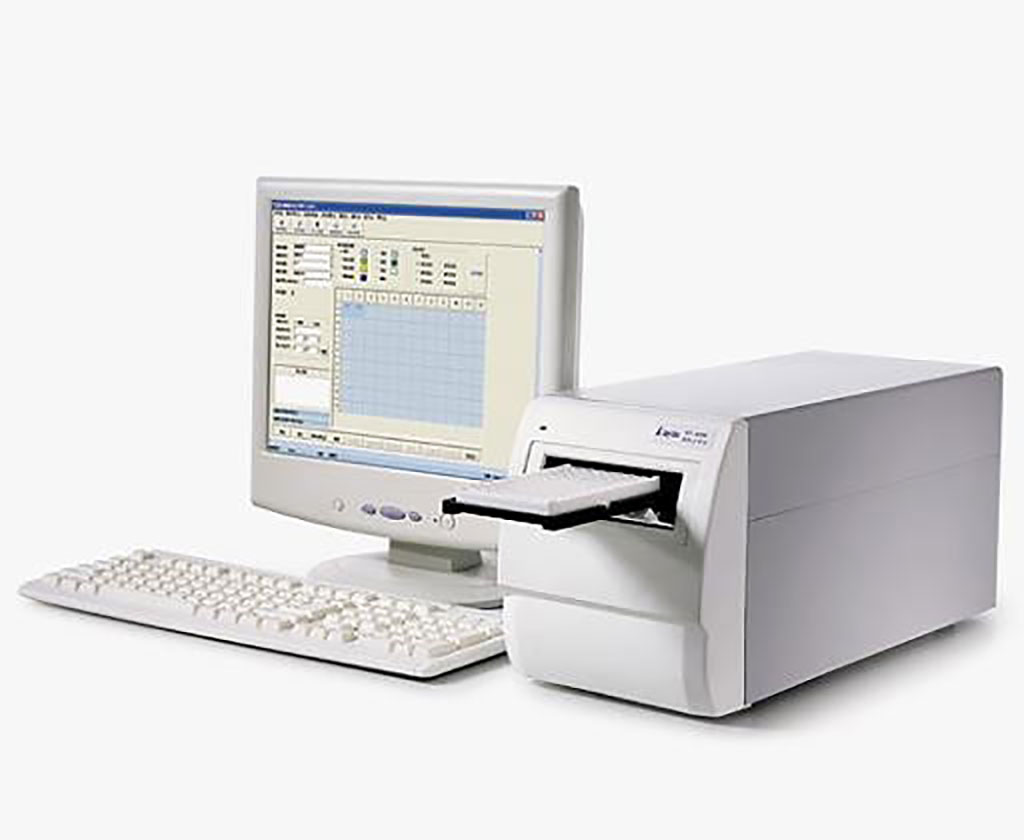Urinary Heat Shock Protein 70 Evaluated in Chronic Prostatitis
|
By LabMedica International staff writers Posted on 21 Apr 2021 |

Image: The Rayto RT‐6500 microplate reader (Photo courtesy of Rayto Life and Analytical Sciences)
Chronic prostatitis (CP) is a common, but a confusing urological disease that seriously affects men's lives and health and cannot be ignored. The incidence rate is increasing, and the disease is affecting younger men and long‐term prostatitis affects male sexual function.
The etiology and pathogenesis of CP are very complicated. Studies have shown that the detection of heat shock protein 70 (HSP70) levels in the expressed prostatic secretions (EPS) of CP patients suggests that it is involved in the process of inflammation. However, EPS can be obtained by anal prostate massage, which is noticeably painful, invasive, and intolerable for some patients.
Clinical Laboratory Scientists at the Guangxi Medical University (Nanning, China) explored the diagnostic value of the levels of prostatic exosomal protein (PSEP) and heat shock protein 70 (HSP70) in the urine of patients with chronic prostatitis (CP). Urine samples from 210 CP patients (70 cases of the USA National Institutes of Health Category II [NIH‐II], 70 NIH‐IIIa, and 70 NIH‐IIIb patients) and 70 control subjects were collected between May 2018 and February 2020.
The team used enzyme‐linked immunosorbent assay (ELISA) to detect PSEP and HSP70 in the urine samples. The PSEP kit was provided by Angke Biotechnology Co., Ltd., (Taicang, China) and the HSP70 kit was provided by Shanghai Enzyme Link Biotechnology Co., Ltd (Shanghai City; China). The investigators read and recorded the absorbance value of the Rayto RT‐6500 microplate reader (Rayto Life and Analytical Sciences Co., Shenzhen, China), in dual‐wavelength mode (450 nm is the test wavelength; 630 nm is the reference wavelength). The differences in urine PSEP and HSP70 levels between the groups were analyzed, and receiver operating characteristic (ROC) curves were used to analyze the clinical value of PSEP and HSP70 in the diagnosis of CP.
The investigators reported that the PSEP levels of CP patients were significantly higher than those of the control group, but there was no difference in PSEP levels among CP subgroups. The level of HSP70 in the urine of the NIH‐II patients was significantly lower than the levels in the NIH‐IIIa and NIH‐IIIb subgroups and the control group, but there was no difference in HSP70 levels between the NIH‐IIIa and NIH‐IIIb subgroups and the control group. ROC curve analysis results showed that the area under the curve (AUC) of PSEP for the NIH‐II, NIH‐IIIa, and NIH‐IIIb patients was 0.751, 0.776, and 0.731, respectively. The AUC of HSP70 in NIH‐II patients was 0.784, and the AUC of combined detection of PSEP and HSP70 in NIH‐II patients was 0.858.
The authors concluded that urinary PSEP can be used as a marker for the diagnosis of CP, but it cannot distinguish the CP subtypes, and HSP70 can be used as a diagnostic index for NIH‐II classification. Both provide a novel, simple, non‐invasive, and painless molecular detection method for CP diagnosis. The study was published on April 6, 2021 in the Journal of Clinical Laboratory Analysis.
Related Links:
Guangxi Medical University
Angke Biotechnology Co., Ltd
Shanghai Enzyme Link Biotechnology
Rayto Life and Analytical Sciences
The etiology and pathogenesis of CP are very complicated. Studies have shown that the detection of heat shock protein 70 (HSP70) levels in the expressed prostatic secretions (EPS) of CP patients suggests that it is involved in the process of inflammation. However, EPS can be obtained by anal prostate massage, which is noticeably painful, invasive, and intolerable for some patients.
Clinical Laboratory Scientists at the Guangxi Medical University (Nanning, China) explored the diagnostic value of the levels of prostatic exosomal protein (PSEP) and heat shock protein 70 (HSP70) in the urine of patients with chronic prostatitis (CP). Urine samples from 210 CP patients (70 cases of the USA National Institutes of Health Category II [NIH‐II], 70 NIH‐IIIa, and 70 NIH‐IIIb patients) and 70 control subjects were collected between May 2018 and February 2020.
The team used enzyme‐linked immunosorbent assay (ELISA) to detect PSEP and HSP70 in the urine samples. The PSEP kit was provided by Angke Biotechnology Co., Ltd., (Taicang, China) and the HSP70 kit was provided by Shanghai Enzyme Link Biotechnology Co., Ltd (Shanghai City; China). The investigators read and recorded the absorbance value of the Rayto RT‐6500 microplate reader (Rayto Life and Analytical Sciences Co., Shenzhen, China), in dual‐wavelength mode (450 nm is the test wavelength; 630 nm is the reference wavelength). The differences in urine PSEP and HSP70 levels between the groups were analyzed, and receiver operating characteristic (ROC) curves were used to analyze the clinical value of PSEP and HSP70 in the diagnosis of CP.
The investigators reported that the PSEP levels of CP patients were significantly higher than those of the control group, but there was no difference in PSEP levels among CP subgroups. The level of HSP70 in the urine of the NIH‐II patients was significantly lower than the levels in the NIH‐IIIa and NIH‐IIIb subgroups and the control group, but there was no difference in HSP70 levels between the NIH‐IIIa and NIH‐IIIb subgroups and the control group. ROC curve analysis results showed that the area under the curve (AUC) of PSEP for the NIH‐II, NIH‐IIIa, and NIH‐IIIb patients was 0.751, 0.776, and 0.731, respectively. The AUC of HSP70 in NIH‐II patients was 0.784, and the AUC of combined detection of PSEP and HSP70 in NIH‐II patients was 0.858.
The authors concluded that urinary PSEP can be used as a marker for the diagnosis of CP, but it cannot distinguish the CP subtypes, and HSP70 can be used as a diagnostic index for NIH‐II classification. Both provide a novel, simple, non‐invasive, and painless molecular detection method for CP diagnosis. The study was published on April 6, 2021 in the Journal of Clinical Laboratory Analysis.
Related Links:
Guangxi Medical University
Angke Biotechnology Co., Ltd
Shanghai Enzyme Link Biotechnology
Rayto Life and Analytical Sciences
Latest Clinical Chem. News
- Blood Test Could Predict and Identify Early Relapses in Myeloma Patients
- Compact Raman Imaging System Detects Subtle Tumor Signals
- Noninvasive Blood-Glucose Monitoring to Replace Finger Pricks for Diabetics
- POC Breath Diagnostic System to Detect Pneumonia-Causing Pathogens
- Online Tool Detects Drug Exposure Directly from Patient Samples
- Chemical Imaging Probe Could Track and Treat Prostate Cancer
- Mismatch Between Two Common Kidney Function Tests Indicates Serious Health Problems
- VOCs Show Promise for Early Multi-Cancer Detection
- Portable Raman Spectroscopy Offers Cost-Effective Kidney Disease Diagnosis at POC
- Gold Nanoparticles to Improve Accuracy of Ovarian Cancer Diagnosis
- Simultaneous Cell Isolation Technology Improves Cancer Diagnostic Accuracy
- Simple Non-Invasive Hair-Based Test Could Speed ALS Diagnosis
- Paper Strip Saliva Test Detects Elevated Uric Acid Levels Without Blood Draws
- Prostate Cancer Markers Based on Chemical Make-Up of Calcifications to Speed Up Detection
- Breath Test Could Help Detect Blood Cancers
- ML-Powered Gas Sensors to Detect Pathogens and AMR at POC
Channels
Molecular Diagnostics
view channel
Multiplex Antibody Assay Could Transform Hepatitis B Immunity Testing
Hepatitis B remains a major global health challenge, yet immunity testing has historically been constrained by cost, operational complexity, and single-analyte approaches. Now, a multiplex antibody assay... Read more
Genetic Testing Improves Comprehensive Risk-Based Screening for Breast Cancer
Breast cancer screening has long relied on age-based guidelines, assuming similar risk across all women despite clear evidence that individual risk varies widely. This one-size-fits-all approach can lead... Read more
Urine Test Could Reveal Real Age and Life Span
Chronological age does not always reflect how quickly the body is aging, as biological age is shaped by genetics, stress, sleep, nutrition, and lifestyle factors such as smoking. A higher biological age... Read more
Genomic Test Identifies African Americans at Risk for Early Prostate Cancer Recurrence
Prostate cancer is one of the most commonly diagnosed cancers in men and a leading cause of cancer-related death, particularly in the United States. African American men face a disproportionately higher... Read moreHematology
view channel
MRD Tests Could Predict Survival in Leukemia Patients
Acute myeloid leukemia is an aggressive blood cancer that disrupts normal blood cell production and often relapses even after intensive treatment. Clinicians currently lack early, reliable markers to predict... Read more
Platelet Activity Blood Test in Middle Age Could Identify Early Alzheimer’s Risk
Early detection of Alzheimer’s disease remains one of the biggest unmet needs in neurology, particularly because the biological changes underlying the disorder begin decades before memory symptoms appear.... Read more
Microvesicles Measurement Could Detect Vascular Injury in Sickle Cell Disease Patients
Assessing disease severity in sickle cell disease (SCD) remains challenging, especially when trying to predict hemolysis, vascular injury, and risk of complications such as vaso-occlusive crises.... Read more
ADLM’s New Coagulation Testing Guidance to Improve Care for Patients on Blood Thinners
Direct oral anticoagulants (DOACs) are one of the most common types of blood thinners. Patients take them to prevent a host of complications that could arise from blood clotting, including stroke, deep... Read moreImmunology
view channel
Ultrasensitive Liquid Biopsy Demonstrates Efficacy in Predicting Immunotherapy Response
Immunotherapy has transformed cancer treatment, but only a small proportion of patients experience lasting benefit, with response rates often remaining between 10% and 20%. Clinicians currently lack reliable... Read more
Blood Test Could Identify Colon Cancer Patients to Benefit from NSAIDs
Colon cancer remains a major cause of cancer-related illness, with many patients facing relapse even after surgery and chemotherapy. Up to 40% of people with stage III disease experience recurrence, highlighting... Read moreMicrobiology
view channel
New UTI Diagnosis Method Delivers Antibiotic Resistance Results 24 Hours Earlier
Urinary tract infections affect around 152 million people every year, making them one of the most common bacterial infections worldwide. In routine medical practice, diagnosis often relies on rapid urine... Read more
Breakthroughs in Microbial Analysis to Enhance Disease Prediction
Microorganisms shape human health, ecosystems, and the planet’s climate, yet identifying them and understanding how they are related remains a major scientific challenge. Even with modern DNA sequencing,... Read morePathology
view channel
Genetics and AI Improve Diagnosis of Aortic Stenosis
Aortic stenosis is a progressive narrowing of the aortic valve that restricts blood flow from the heart and can be fatal if left untreated. There are currently no medical therapies that can prevent or... Read more
AI Tool Simultaneously Identifies Genetic Mutations and Disease Type
Interpreting genetic test results remains a major challenge in modern medicine, particularly for rare and complex diseases. While existing tools can indicate whether a genetic mutation is harmful, they... Read more
Rapid Low-Cost Tests Can Prevent Child Deaths from Contaminated Medicinal Syrups
Medicinal syrups contaminated with toxic chemicals have caused the deaths of hundreds of children worldwide, exposing a critical gap in how these products are tested before reaching patients.... Read more
Tumor Signals in Saliva and Blood Enable Non-Invasive Monitoring of Head and Neck Cancer
Head and neck cancers are among the most aggressive malignancies worldwide, with nearly 900,000 new cases diagnosed each year. Monitoring these cancers for recurrence or relapse typically relies on tissue... Read moreTechnology
view channel
Pioneering Blood Test Detects Lung Cancer Using Infrared Imaging
Detecting cancer early and tracking how it responds to treatment remains a major challenge, particularly when cancer cells are present in extremely low numbers in the bloodstream. Circulating tumor cells... Read more
AI Predicts Colorectal Cancer Survival Using Clinical and Molecular Features
Colorectal cancer is one of the most common and deadly cancers worldwide, and accurately predicting patient survival remains a major clinical challenge. Traditional prognostic tools often rely on either... Read moreIndustry
view channel
BD and Penn Institute Collaborate to Advance Immunotherapy through Flow Cytometry
BD (Becton, Dickinson and Company, Franklin Lakes, NJ, USA) has entered into a strategic collaboration with the Institute for Immunology and Immune Health (I3H, Philadelphia, PA, USA) at the University... Read more










 (3) (1).png)






